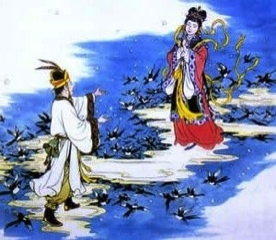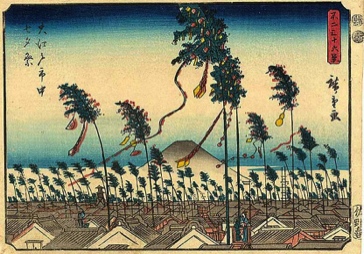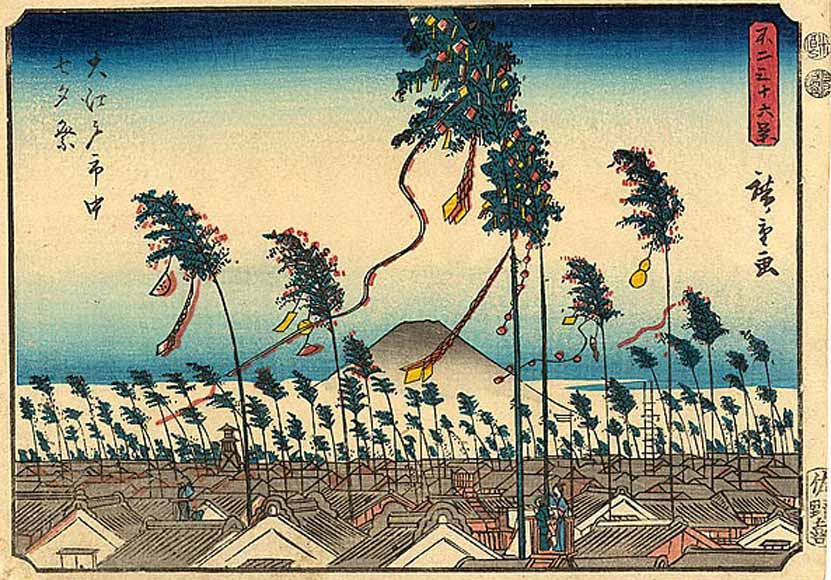Tanabata
symphonic poem for womens choir and orchestra
symphonic poem for womens choir and orchestra
Tanabata is a symphonic poem for womens choir and orchestra inspired by a traditional Japanese story.
The text song by the choir is from ther Manyoshu,
Orchestra : 3.3.3.3-4.3.3.1-Tmp+7-fem choir-str
Premiere in Osaka, July 7th 2011
The text song by the choir is from ther Manyoshu,
Orchestra : 3.3.3.3-4.3.3.1-Tmp+7-fem choir-str
Premiere in Osaka, July 7th 2011

The piece started with the world of the stars, a perfect and concentrate world expressed by a sort of musical magma that becomes very bright
Then appears the world of earth, a world of liberty with strong rhythms where the princess of the stars will find a true love (here the choir sings on a Manyochou poem about eternal love)
A love that is interrupted suddenly and violently (percussion, bass drum)
The orchestra plays the tears of the princess and the second choir sings on a poem about the pain and the frustration caused by this separation.
Then comes the announce that the day of Tanabata will arrive, a day where the beauty of eternal love will be always celebrate.
Tanabata (七夕, meaning "Evening of the seventh") is a Japanese star festival, originating from the Chinese Qixi Festival. It celebrates the meeting of the deities Orihime and Hikoboshi (represented by the stars Vega and Altair respectively). According to legend, the Milky Way separates these lovers, and they are allowed to meet only once a year on the seventh day of the seventh lunar month of the lunisolar calendar. The date of Tanabata varies by region of the country, but the first festivities begin on July 7 of the Gregorian calendar. The celebration is held at various days between July and August.
Man'yōshū (万葉集 man'yōshū, "Collection of Ten Thousand Leaves") is the oldest existing collection of Japanese poetry, compiled some time after 759 AD during the Nara period. The anthology is one of the most revered of Japan's poetic compilations. The compiler, or the last in a series of compilers, is believed to be Ōtomo no Yakamochi. The collection contains poems ranging from AD 347 (poems #85-89) through 759 (#4516),[2] the bulk of them representing the period after 600.


Like Qixi and Chilseok, Tanabata was inspired by the famous Chinese folklore story, "The Princess and the Cowherd". Some versions were included in the Man'yōshū, the oldest extant collection of Japanese poetry.[
The most popular version is as follows:
Orihime (織姫 Weaving Princess?), daughter of the Tentei (天帝 Sky King, or the universe itself?), wove beautiful clothes by the bank of the Amanogawa (天の川 Milky Way, lit. "heavenly river"?). Her father loved the cloth that she wove and so she worked very hard every day to weave it. However, Orihime was sad that because of her hard work she could never meet and fall in love with anyone. Concerned about his daughter, Tentei arranged for her to meet Hikoboshi (彦星 Cow Herder Star?)(also referred to as Kengyuu (牽牛?)) who lived and worked on the other side of the Amanogawa. When the two met, they fell instantly in love with each other and married shortly thereafter. However, once married, Orihime no longer would weave cloth for Tentei and Hikoboshi allowed his cows to stray all over Heaven. In anger, Tentei separated the two lovers across the Amanogawa and forbade them to meet. Orihime became despondent at the loss of her husband and asked her father to let them meet again. Tentei was moved by his daughter’s tears and allowed the two to meet on the 7th day of the 7th month if she worked hard and finished her weaving. The first time they tried to meet, however, they found that they could not cross the river because there was no bridge. Orihime cried so much that a flock of magpies came and promised to make a bridge with their wings so that she could cross the river. It is said that if it rains on Tanabata, the magpies cannot come and the two lovers must wait until another year to meet.

